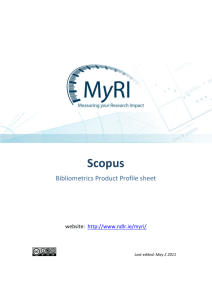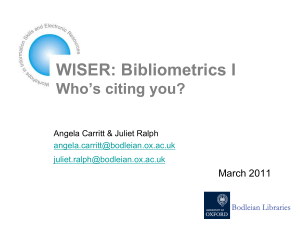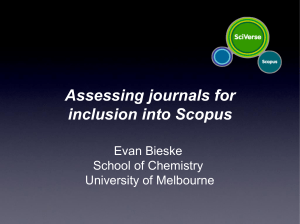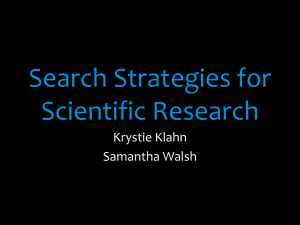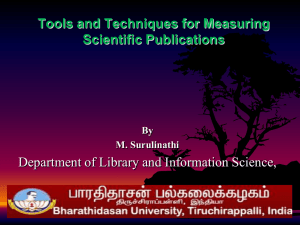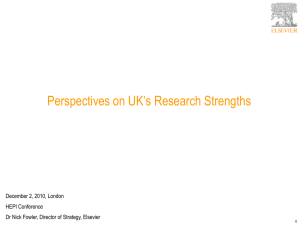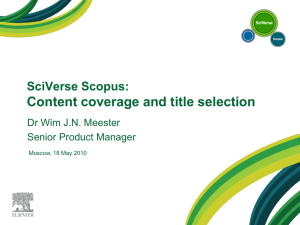h Index of HCI Researchers: Scopus vs. WoS
advertisement
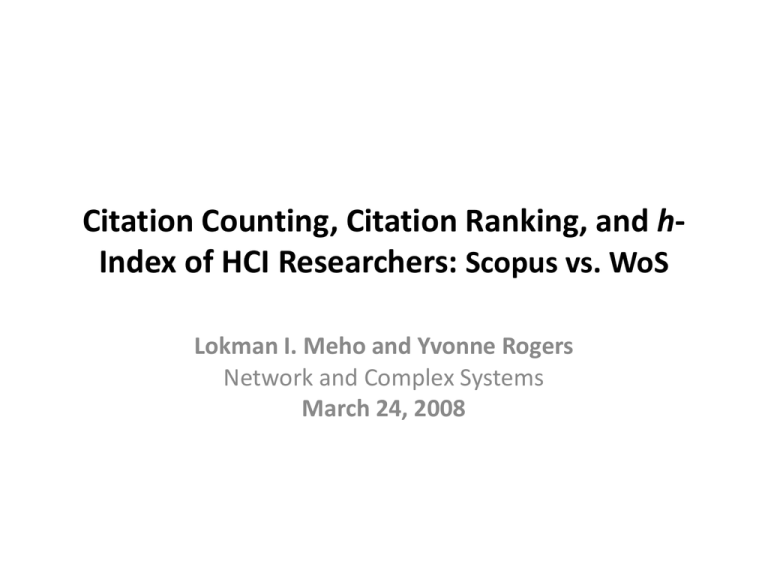
Citation Counting, Citation Ranking, and hIndex of HCI Researchers: Scopus vs. WoS Lokman I. Meho and Yvonne Rogers Network and Complex Systems March 24, 2008 Why citation analysis? • Study the evolution of scientific disciplines • Examine and/or map the social, economic, political, and intellectual impact of scientific research • Assist in certain decisions (promotion, tenure, hiring, grants, collaboration, etc.) Research problem • Until today, most citation-based research rely exclusively on data obtained from the Web of Science database • Emergence of Scopus and Google Scholar has raised many questions regarding the use of Web of Science exclusively Literature review • The question of whether to use Scopus and/or Web of Science as part of a mapping or research assessment exercise might be domain-dependent and that more in-depth studies are needed to verify the strengths and limitations of each source • Scopus covers 84% of all journal titles indexed in Web of Science; Web of Science covers 54% of all journal titles indexed in Scopus Research questions • How do the two databases compare in their coverage of HCI literature and the literature that cites it, and what are the reasons for the differences? • What impact do the differences in coverage between the two databases have on the citation counting, citation ranking, and h-index scores of HCI researchers? • Should one or both databases be used for determining the citation counting, citation ranking, and h-index scores of HCI researchers? Significance/value of study • Determine whether citation searching in HCI should be extended to both Scopus and Web of Science or limited to one of them. • Will help people who use citation analysis for research evaluation and mapping exercises justify their choice of database Databases • Web of Science – Approximately 9,000 journals going back to 1955 – Books in series and an unknown number of conf. proceedings, including LNCS, LNAI, LNM • Scopus – 14,000 journals going back to 1996 for citations – 500 conference proceedings – 600 trade publications Methods • Sample – 22 top HCI researchers from the Equator Interdisciplinary Research Collaboration, a project funded by UK’s Engineering and Physical Sciences Research Council (six years) • Publications (n=1,440, mainly conf papers and journal articles) – 594 (41%) were covered by Scopus – 296 (21%) were covered by Web of Science – 647 (45%) were covered by both Methods, cont’d • Searching methods used to identify citations to the 1,440 items published/produced by the sample members: – Scopus: (1) exact match of each item in “References” field; (2) “More” tab; and (3) “Author” search results + “Cited by” – WoS: cited references search • Citation information was parsed by author, publication type, year, source name, institution, country, and language • Source names were manually standardized and missing institutional affiliation and country information (3%) was gleaned from the web Methods, cont’d • Data from both databases were crossexamined for accuracy • h-index – Definition, strengths, and limitations – System-based counting method (takes into account only indexed works, n=647 works) – Manual-based counting method (takes into account all 1,440 works published/produced by sample) Results: Distribution of unique and overlapping citations Scopus Web of Science n=6,919 (93%) n=4,011 (54%) 520 (7%) 3,491 (47%) 3,428 (46%) WoS Scopus = 7,439* *Excludes 255 citations from WoS, published before 1996 11 Results: Reasons for the significant differences Note: 76% of all citations found in conference proceedings were unique to a single database, in comparison to 34% in the case of citations in journals Results: Quality of Scopus unique citing journals Rank Sources of citations WoS Scopus Union 1 Presence: Teleoperators and Virtual Environments 156 155 159 1.480 (10) 1.000 2 International Journal of Human-Computer Studies 130 123 131 1.615 (7) 1.094 3 Interacting with Computers 113 105 115 1.140 (17) 0.833 4 Computer Supported Cooperative Work - 91 91 2.000 (4) NA 5T Cyberpsychology & Behavior 53 53 60 1.269 (13) 1.061 5T IEEE Pervasive Computing 50 48 60 2.971 (2) 2.062 5T Personal and Ubiquitous Computing* 48 57 60 1.427 (12) NA 8 Behaviour & Information Technology 57 58 59 1.097 (19) 0.743 9 J. of the Am. Soc. for Info. Sci. and Tech. 53 46 55 1.766 (6) 1.555 10 Human-Computer Interaction 44 41 46 3.043 (1) 2.391 - 23 23 2.861 (3) NA - 23 23 0.565 (22) NA 19T ACM Transactions on Computer-Human Interaction 19T New Review of Hypermedia and Multimedia This is a partial list of the top 20 citing journals Scopus IF JCR Impact (rank) Factor Results: Quality of Scopus’s citing conference proceedings (top 9 citing titles) Rank 1 2 3 4 5 6 Sources of citations ACM Conference on Human Factors in Computing Systems ACM Conference on Computer Supported Cooperative Work Ubicomp: Ubiquitous Computing, Proceedings (LNCS) IEEE International Conference on Pervasive Computing and Communications, PerCom Proceedings of SPIE - The International Society for Optical Engineering ACM Conference on Human-Computer Interaction with Mobile Devices and Services, MobileHCI (LNCS) 7 IEEE Virtual Reality Conference 8 ACM Conference on Hypertext and Hypermedia** 9 ACM Conference on Designing Interactive Systems, DIS *Source: Scopus. WoS citations Not indexed Not indexed 67 Not indexed Not indexed 45 Not indexed Not indexed Not indexed Scopus citations Union citations IF* (rank) 211 211 2.478 (1) 72 72 - 55 69 - 64 64 0.934 (3) 60 60 - 48 58 - 51 51 0.612 (5) 49 49 0.915 (4) 45 45 - Differences in citation counting and ranking of individual researchers (top 12) Name Web of Science Scopus Difference Union of Web of Science and Scopus Count Ranking Count Ranking Count Ranking Count (%) Ranking Rogers* 753 1 1,229 1 476 (63%) 0 1,319 1 Benford* 572 3 1,179 2 607 (106%) 1 1,244 2 Rodden* 577 2 1,075 3 498 (86%) -1 1,138 3 De Roure* 421 5 764 4 343 (81%) 1 834 4 Gaver* 427 4 704 5 277 (65%) -1 753 5 Friday* 348 8 649 6 301 (86%) 2 677 6 Schmidt 329 9 607 7 278 (84%) 2 654 7 Gellersen* 311 10 591 8 280 (90%) 2 627 8 Cheverst 352 7 586 9 234 (66%) -2 618 9 Steed* 354 6 584 10 230 (65%) -4 615 10 Chalmers* 256 11 414 11 158 (62%) 0 442 11 Crabtree 136 14 326 12 190 (140%) 2 334 12 TOTAL 4,011 6,919 2,908 (73%) 7,439 Differences in mapping scholarly impact of individual researchers: an example Researcher Web of Science Scopus % Mismatch Top Citing Authors Benford Pilar Herrero (10) Chris Greenhalgh (6) Ling Chen (5) Jin Zhang (5) Paul Luff (4) Minh Hong Tran (4) Pilar Herrero (13) Ling Chen (10) Andy Crabtree (10) Azzedine Boukerche (8) Carl Gutwin (7) 64% Top Citing Sources Benford Presence: Teleoperators and Virtual Environments (57) UbiComp (21) International Journal of HumanComputer Studies (15) Interacting with Computers (14) CHI Conference (58) Presence: Teleoperators and Virtual Environments (57) Int. Conf. on Collaborative Virtual Environments (32) Personal and Ubiquitous Computing (11) IEEE Virtual Reality Conference (22) Computer Supported Cooperative Work (31) 80% Differences in mapping scholarly impact of individual researchers, cont’d Researcher Web of Science Scopus % Mismatch Top Citing Institutions* Benford University of Nottingham (33) University of Sussex (14) Lancaster University (11) Universidad Politécnica de Madrid (10) King's College London (8) University of Nottingham (80) University of Ottawa (23) University College London (21) Zhejiang University (19) Fraunhofer-Gesellschaft (16) Georgia Institute of Technology (16) Lancaster University (16) 67% Top Citing Countries Benford United Kingdom (158) United States (127) Germany (30) Japan (28) Australia (25) United Kingdom (312) United States (234) China (69) Japan (65) Canada (52) 40% *Percentage of mismatch would have been higher had we removed citations from the home institution of the researcher Differences in average h-index Difference in h-index of individual researchers Web of Science Scopus Union of WoS and Scopus Difference System count Manual count System count Manual count System count Manual count Benford* 7 14 12 22 12 24 100% Rodden* 5 13 12 19 12 21 75% Gaver* 3 14 8 20 8 20 150% De Roure* 6 12 8 17 9 19 111% Rogers* 7 11 9 15 9 17 89% Steed* 6 11 10 16 10 16 60% Gellersen* 6 8 10 14 10 15 50% Schmidt 5 9 9 14 9 15 67% Chalmers* 2 7 8 13 8 13 63% Cheverst 5 9 7 12 7 13 86% 3.5 8.0 6.8 12.3 6.9 13.0 89% AVERAGE This is a partial list of the top 10 researchers Comparison of h-index between GS and WoS+Scopus Researcher Benford* Rodden* Gaver* De Roure* Rogers* Cheverst Gellersen* Steed* Schmidt Friday* Chalmers* Crabtree Brown Fitzpatrick* Muller* Stanton-Fraser Weal Randell Izadi Schnädelbach Barkhuus Price AVERAGE Union of WoS and Scopus Score Rank 24 1 21 2 20 3 19 4 17 5 13 9T 15 7T 16 6 15 7T 13 9T 13 9T 13 9T 10 14T 10 14T 9 17T 11 13 10 14T 9 17T 8 19 7 20 6 21T 6 21T 13.0 Google Scholar Score Rank 38 1T 38 1T 32 3 27 4T 27 4T 25 6T 25 6T 25 6T 24 9 23 10 21 11 20 12 18 13 17 14 15 15T 15 15T 14 17 13 18 12 19 9 20 8 21T 8 21T 20.6 Difference 58% 81% 60% 42% 59% 92% 67% 56% 60% 77% 62% 54% 80% 70% 67% 36% 40% 44% 50% 29% 33% 33% 59% Conclusions and implications • In HCI, conference proceedings constitute a major channel of written communication • Most of these proceedings are published by ACM and IEEE and also by Springer in the form of LNCS and LNAI • Scopus should be used instead of WoS for citation-based research and evaluation in HCI Conclusions and implications, cont’d • h-index should be manually calculated rather than relying on system-generated scores • Researchers can no longer limit themselves to WoS just because they are familiar with it, have access to it, or because it is the more established data source • A challenge is to systematically explore citation data sources to determine which one(s) are better for what research domains Conclusions and implications, cont’d • Principles of good bibliometrics research: – Analysis should be applied only by professional people with theoretical understanding and thorough technical knowledge of the databases, retrieval languages, and the abbreviations, concepts, and/or terminologies of the domain under investigation – Analysis should only be used in accordance with the established principles of “best practice” of professional bibliometrics – If utilized for research assessment purposes, citation-based information should only be used in conjunction with qualitative peer review-based information Thank You Questions? meho@indiana.edu Full paper available at: http://www.slis.indiana.edu/faculty/meho/meho-rogers.pdf March 24, 2008 Network and Complex Systems 24
